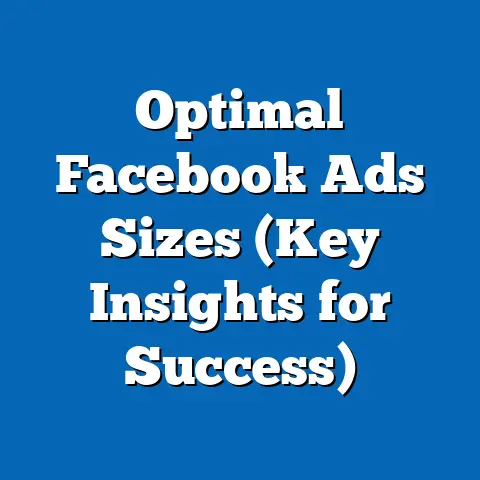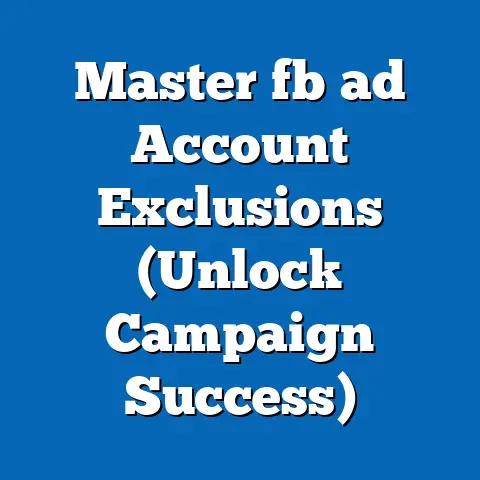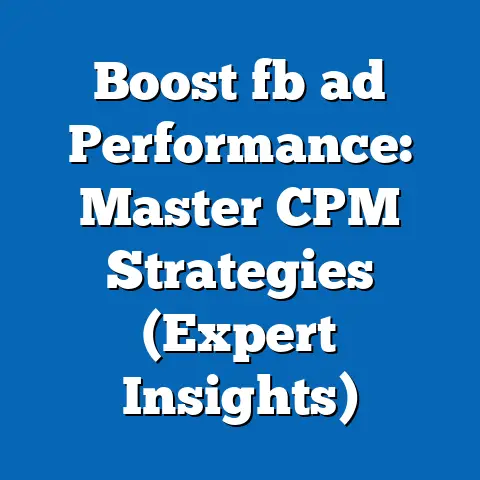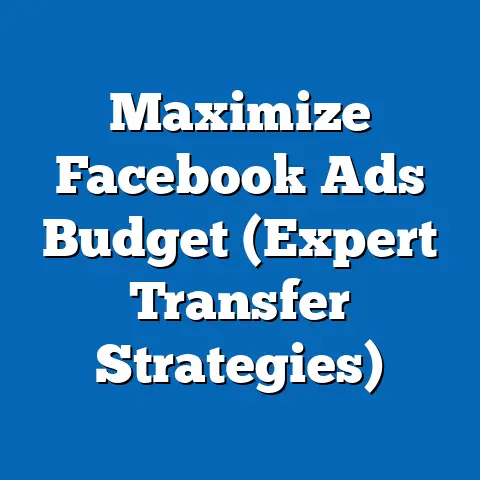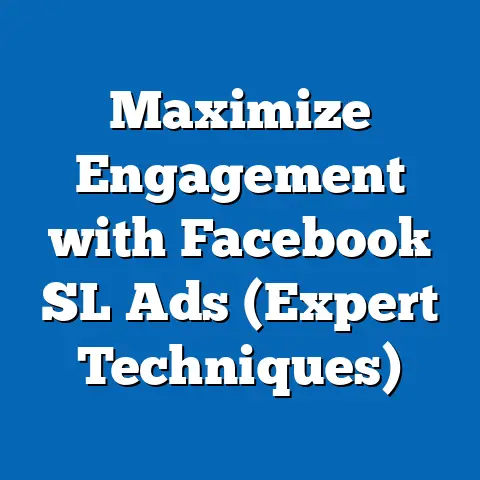Maximize Profits with Affiliation Link Facebook Ads (Expert Tips)
In today’s world, health is no longer a trend; it’s a way of life. We’re bombarded with information about wellness, nutrition, and fitness, and as a result, consumers are more health-conscious than ever before. This heightened awareness presents a golden opportunity for businesses and marketers, especially those looking to tap into the lucrative health niche through affiliate marketing. Facebook ads are a powerful tool to promote health-focused affiliate products, and with the right strategies, you can significantly maximize your profits. I’ve seen firsthand how a well-executed Facebook ad campaign can transform a small affiliate venture into a thriving online business. The beauty of affiliate marketing is its low-risk, high-reward potential, making it an ideal entry point for anyone eager to make their mark in the digital world. Let’s dive into the expert tips that will help you master the art of affiliate marketing through Facebook ads.
Understanding Facebook Ads and Affiliate Marketing
First, let’s break down the basics. Facebook ads are advertisements that businesses pay to display on Facebook’s platform. What makes them so powerful is their precise targeting capabilities. You can target users based on demographics (age, location, gender), interests (fitness, nutrition, yoga), behaviors (purchase history, online activity), and more. Facebook Ads Manager is your central hub for creating, managing, and tracking your ad campaigns.
Affiliate marketing, on the other hand, is a performance-based marketing strategy where you earn a commission for promoting someone else’s products or services. In the health niche, this could involve promoting anything from dietary supplements and fitness programs to wellness apps and health equipment.
Key Takeaway: Facebook ads offer unparalleled targeting capabilities, and affiliate marketing provides a low-risk way to monetize the growing health and wellness market.
Choosing the Right Affiliate Health Products
Not all affiliate products are created equal. Selecting the right products to promote is crucial for success. Here’s what I look for when choosing affiliate health products:
- Quality and Credibility: This is non-negotiable. Promote products from reputable brands with positive reviews and scientific backing. Your reputation is on the line, so don’t risk it by promoting subpar products. I once promoted a weight loss supplement from an unknown brand and received a flood of complaints about its ineffectiveness. I quickly removed it from my promotions and learned a valuable lesson.
- Relevance: The product should align with your target audience’s needs and interests. If you’re targeting fitness enthusiasts, promote protein powders, workout gear, or gym memberships. If you’re targeting people interested in weight loss, focus on diet plans, meal replacements, or exercise equipment.
- Affiliate Program Terms: Pay attention to commission rates, payment schedules, and cookie durations (the length of time you’ll receive credit for a sale after someone clicks your affiliate link). A higher commission rate is always appealing, but also consider the product’s conversion potential.
- Product Demand: Research the demand for the product using tools like Google Trends, SEMrush, or Ahrefs. Look for products with consistent search volume and positive trends.
- Target Audience Preferences: Understand what your target audience is looking for. Read reviews, participate in online communities, and conduct surveys to gather insights.
Some popular health products that consistently perform well in affiliate marketing include:
- Supplements: Protein powders, vitamins, probiotics, and weight loss supplements.
- Fitness Programs: Online workout programs, personal training services, and gym memberships.
- Wellness Apps: Meditation apps, sleep trackers, and mental health apps.
- Health Equipment: Fitness trackers, smart scales, and home exercise equipment.
Key Takeaway: Focus on promoting high-quality, relevant, and in-demand health products from reputable brands with favorable affiliate program terms.
Crafting Compelling Ad Copy
Your ad copy is your sales pitch. It needs to grab attention, pique interest, and persuade people to click your affiliate link. Here are some essential elements of effective ad copy in the health niche:
- Address Pain Points and Benefits: Start by identifying the problems your target audience is facing and then highlight how your product can solve those problems. For example, instead of saying “Our protein powder is high in protein,” say “Tired of feeling sluggish after your workouts? Our protein powder provides sustained energy and helps you recover faster.”
- Use Persuasive Language: Employ power words like “transform,” “achieve,” “discover,” and “guarantee” to make your ad copy more compelling. Avoid overly hypey or salesy language, as it can turn people off.
- Incorporate Calls to Action (CTAs): Tell people exactly what you want them to do. Use clear and concise CTAs like “Shop Now,” “Learn More,” “Get Started,” or “Download Now.”
- Leverage Testimonials and Social Proof: Include customer testimonials or reviews to build trust and credibility. Social proof is incredibly powerful in the health niche, where people are often skeptical of marketing claims.
- Tell a Story: Storytelling is a great way to connect with your audience on an emotional level. Share a personal story or a customer success story to illustrate the benefits of your product.
Here are a few examples of effective ad copy for the health niche:
- Example 1 (Weight Loss Supplement): “Struggling to lose those last few pounds? [Product Name] is a natural weight loss supplement that helps you burn fat, boost your metabolism, and curb your cravings. Get a slimmer, healthier you today! Shop Now.”
- Example 2 (Fitness Program): “Transform your body in just 30 days with [Program Name]! Our online workout program provides personalized training, expert guidance, and a supportive community to help you reach your fitness goals. Get started today!”
- Example 3 (Meditation App): “Feeling stressed and anxious? [App Name] is a meditation app that helps you calm your mind, reduce stress, and improve your sleep. Download now and start your journey to inner peace.”
I once ran an ad campaign for a yoga mat that featured a customer testimonial about how the mat had improved their practice and reduced their joint pain. The ad copy resonated with my target audience, and the campaign generated a significant number of sales.
Key Takeaway: Craft compelling ad copy that addresses pain points, highlights benefits, uses persuasive language, incorporates CTAs, leverages testimonials, and tells a story.
Visual Elements and Design
Visuals are crucial for capturing attention on Facebook. A well-designed ad can significantly increase engagement and click-through rates. Here are some best practices for choosing images and videos in the health niche:
- Align with Health and Wellness Themes: Use images and videos that evoke feelings of health, vitality, and well-being. Think of people exercising, eating healthy foods, meditating, or enjoying nature.
- Use High-Quality Visuals: Avoid blurry, pixelated, or poorly lit images. Invest in professional photography or use stock photos from reputable sources like Unsplash or Pexels.
- Comply with Facebook’s Ad Policies: Facebook has strict guidelines about what you can and can’t show in your ads, particularly in the health niche. Avoid showing before-and-after photos, making unrealistic claims, or targeting vulnerable populations.
- Use Colors Strategically: Colors can evoke different emotions and associations. Green is often associated with health and nature, blue with calmness and trust, and yellow with energy and optimism.
- Choose the Right Ad Format: Facebook offers a variety of ad formats, including single image ads, video ads, carousel ads, and collection ads. Choose the format that best suits your product and message.
I’ve found that video ads tend to perform particularly well in the health niche, as they allow you to showcase the product in action and tell a more compelling story. For example, a video of someone using a fitness tracker while running can be more engaging than a static image of the tracker.
Some useful tools for designing professional-looking ads include:
- Canva: A user-friendly graphic design tool with a wide range of templates and design elements.
- Adobe Spark: A more advanced design tool that offers more customization options.
- Animoto: A video creation tool that allows you to easily create engaging video ads.
Key Takeaway: Use high-quality visuals that align with health and wellness themes, comply with Facebook’s ad policies, and choose the right ad format to maximize engagement.
Targeting Your Audience Effectively
Targeting is where Facebook ads truly shine. By targeting the right audience, you can ensure that your ads are seen by people who are most likely to be interested in your product. Here are some strategies for effective audience targeting in the health niche:
- Use Facebook’s Audience Insights Tool: This tool provides valuable data about your target audience, including their demographics, interests, behaviors, and page likes.
- Create Custom Audiences: Custom audiences allow you to target people who have already interacted with your business, such as website visitors, email subscribers, or customers.
- Create Lookalike Audiences: Lookalike audiences allow you to target people who are similar to your existing customers or website visitors. This is a great way to expand your reach and find new customers.
- Target Specific Interests: Target people who are interested in specific health topics, such as fitness, nutrition, weight loss, yoga, or meditation.
- Target Specific Behaviors: Target people who have specific health-related behaviors, such as purchasing health products online, visiting health websites, or participating in fitness activities.
Here are some examples of specific targeting strategies that have proven effective in the health niche:
- Target women aged 25-45 who are interested in weight loss and follow fitness influencers on Instagram.
- Target men aged 35-55 who are interested in bodybuilding and purchase protein supplements online.
- Target people who have visited your website in the past 30 days and are interested in meditation apps.
I once ran an ad campaign for a sleep tracker that was specifically targeted at people who had expressed interest in sleep disorders and had visited websites about insomnia. The campaign performed exceptionally well, as it was highly relevant to the target audience’s needs.
Key Takeaway: Use Facebook’s audience insights tool, create custom and lookalike audiences, and target specific interests and behaviors to maximize ad relevance and performance.
Analyzing and Optimizing Ad Performance
Monitoring and optimizing your ad performance is crucial for ensuring profitability. Here are some key performance indicators (KPIs) to track:
- Click-Through Rate (CTR): The percentage of people who see your ad and click on it. A high CTR indicates that your ad copy and visuals are engaging.
- Conversion Rate: The percentage of people who click on your ad and then make a purchase or take another desired action. A high conversion rate indicates that your product is appealing and your landing page is effective.
- Return on Ad Spend (ROAS): The amount of revenue you generate for every dollar you spend on advertising. A high ROAS indicates that your ad campaign is profitable.
- Cost Per Click (CPC): The amount you pay for each click on your ad. A low CPC indicates that your targeting is effective and your ad is relevant.
- Cost Per Acquisition (CPA): The amount you pay for each customer you acquire through your ad campaign. A low CPA indicates that your ad campaign is efficient.
Use A/B testing to experiment with different ad copy, visuals, targeting options, and landing pages to see what works best. A/B testing involves creating two versions of an ad (A and B) and then showing each version to a different segment of your audience. By tracking the performance of each version, you can identify which one is more effective.
Based on your performance data, adjust your budgets and bids to maximize profits. If an ad campaign is performing well, increase your budget to reach a wider audience. If an ad campaign is underperforming, lower your budget or pause the campaign altogether.
I regularly review my ad performance data and make adjustments to my campaigns based on the results. I’ve found that even small changes can have a significant impact on my ROAS. For example, I once increased my ROAS by 20% simply by changing the headline of my ad copy.
Key Takeaway: Monitor your ad performance metrics, use A/B testing to refine your strategies, and adjust your budgets and bids based on performance data to maximize profits.
Conclusion
Using Facebook ads with affiliate links offers a powerful way to tap into the lucrative health market. By following the expert tips outlined in this article, you can craft compelling ad copy, choose engaging visuals, target your audience effectively, and analyze and optimize your ad performance to maximize your profits.
Remember, the world of digital marketing is constantly evolving, so it’s essential to stay up-to-date with the latest trends and best practices. Continuously learn, experiment, and adapt your strategies to stay ahead of the curve.
Don’t be afraid to take action and implement the tips provided in this article. Start small, test different approaches, and track your results. With dedication and perseverance, you can achieve significant success with Facebook ads and affiliate marketing in the health niche. I encourage you to start today and unlock the potential for profit and growth in this exciting and ever-expanding market.


